Oct 21, 2013
In an unprecedented exhibition, the Asian Art Museum presents masterworks from Korea.
Download a PDF copy of this Press Release: English | Korean | Public Programs
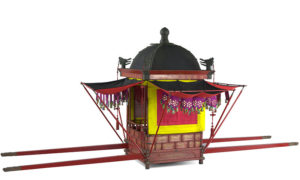
Updated on Oct. 21, 2013
SAN FRANCISCO, Oct. 10, 2013—This October, the Asian Art Museum will present In Grand Style: Celebrations in Korean Art during the Joseon Dynasty, the first major U.S. exhibition to explore the colorfully choreographed ceremonies of Korea’s Joseon dynasty (1392–1910). The legacy of this dynasty—among the world’s longest—continues to resonate in Korean culture today. On view Oct. 25, 2013–Jan. 12, 2014, the exhibition features more than 110 important objects (several officially designated as Korean treasures by Korea’s Cultural Heritage Administration) that bring to life the grand festivals in which milestones like birthdays, weddings and political appointments were celebrated with elaborate rites that sometimes involved thousands of participants and continued for days. Dance, music, cuisine and procession all had parts in the joyous festivities, while rules were prescribed that governed practically every detail of the celebrations.
The careful, detailed organization of extensive events during the dynasty sprang from the country’s national ideology of Confucianism, which considered ritual and order the foundations of a stable, peaceful civilization. Many of these celebrations were recorded in comprehensive detail through writings and paintings in multivolume books known as “royal protocols” (uigwe). These documents are so detailed that it is possible to reconstruct the ceremonies even today, a century after the end of Korea’s period of royal rule.
Through the artworks, In Grand Style explores four key themes: what it meant to be a king during the Joseon dynasty; royal processions and banquets; the power of women at the royal court; and the lives and celebrations of the Joseon dynasty’s people. Highlights include an ornate palanquin—measuring more than 8 feet long—used for carrying a king; a book of praise for King Taejo, made entirely of jade and inscribed with gold; a 64-foot-long handscroll depicting King Jeongjo’s famous procession to his father’s tomb; a royal throne; ceremonial robes; as well as kings’ and queens’ seals and protocol books with paintings of royal banquets.
“With In Grand Style we celebrate the rich pageantry of the Joseon dynasty,” said Jay Xu, director of the Asian Art Museum. “It is fitting that we should do so in our 10th year in the museum’s Civic Center location. In 2003 we opened with a show about Korea’s Goryeo dynasty. Ten years later, we celebrate the marvelous arts of Korea, and ultimately the art of celebration itself, through this exhibition focusing on the succeeding Joseon dynasty.”
Lee Gallery: From Birth to the Throne
The selection of artworks in Lee Gallery illustrates the lifestyles and rituals of kings during the Joseon dynasty, from birth to the throne. One unique Korean ritual was the making of placenta jars. Immediately after birth, the tissue surrounding the royal baby, including the placenta and umbilical cord, was placed in a set of jars and kept in a special chamber for the symbolic protection and well-being of the family member throughout life. In the late 15th century, placenta jars of white porcelain took on standardized forms—taller than previous types, and distinctively decorated with four loops on the shoulders, like the placenta jars of Princess Myeong-an in Lee Gallery.
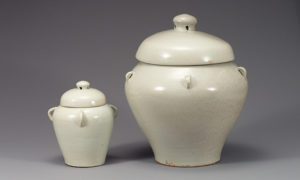
These placenta jars belonged to Princess Myeong-an, daughter of the 17th-century Joseon-dynasty king Hyeonjong. Traditionally, these simple and beautiful porcelain jars were made for storing the placentas of every member of the royal family for symbolic protection, part of the emphasis placed on lineage in Confucian society.
A king of the Joseon dynasty was expected to be succeeded by the eldest surviving son of his queen. An example of this rise to power was King Sunjong (reigned 1907–1910), who had been appointed heir to the throne when he was only one year old, as depicted in Lee Gallery in a painting celebrating his birth and a royal edict appointing him crown prince.
During a king’s lifetime, he would earn honorary titles as celebrations of important moments. Titles were also given after kings’ lifetimes as a sign of respect. King Sukjong (reigned 1674–1720) presented honorary titles to the dynasty’s founding king, King Taejo, hundreds of years after his reign to symbolically strengthen the legitimacy of the dynasty. For the presentation ritual, King Sukjong commissioned a golden seal inscribed with four honorary titles and a stunning book made entirely of jade. Inscribed in glittering gold on the ten jade pages are King Taejo’s accomplishments and deeds.
Artists were commissioned by the royal court to record major events and celebrations in exact detail. With the exception of royal portraits, artists were only allowed to depict kings through paintings of objects used by kings, like a throne. A common symbol of royal authority was the combination of a sun, moon and five peaks in paintings, as seen in the screen on view in Lee Gallery. Elements in this screen represent the universe, with the king symbolically at the center. This artwork is one of the earliest examples of the 20 existing screens of this kind.
Wherever the king went, a screen of this type followed and was set behind a royal throne like the one on view in Lee Gallery. The screen is in impeccable condition and is one of two royal Korean thrones that exist outside of the country’s palaces.
Hambrecht Gallery: Royal Procession and Banquets—Based on King Jeongjo’s 1795 Procession to His Father’s Tomb in the City of Hwaseong
Hambrecht Gallery features artworks from a time often considered the Korean Renaissance. Under the rules of King Yeongjo (reigned 1724–1776) and his grandson, King Jeongjo (reigned 1776–1800), 18th-century Korea saw political stability, active international relations, economic prosperity and cultural innovation.
This gallery showcases objects used in royal processions, which were grand events involving the participation of many people from all levels of the royal court. One of the most elaborate processions was King Jeongjo’s 1795 visit to his father’s tomb in the city of Hwaseong (present-day Suwon) to honor his late father and celebrate his mother’s 60th birthday. Rather than his usual three-day visit to Hwaseong, the king extended the visit to eight days to include a banquet for the queen’s birthday. At the center of Hambrecht Gallery is an impressive 64-foot-long handscroll depicting this famous procession.
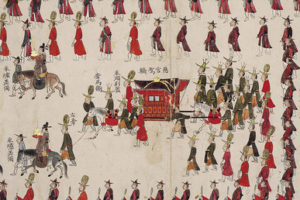
Also on view is a rare folding screen portraying eight major events during King Jeongjo’s visit. One panel illustrates the king’s procession back to Hanyang (present-day Seoul), with the king symbolized in the painting by a grand palanquin. Displayed nearby in Hambrecht is an ornate palanquin from the Joseon dynasty, adorned with auspicious animal images painted in gold, and measuring more than 8 feet long. The palanquin was designed to be held by 16 servants, four at each pole.
Osher Gallery: Power of Women at the Royal Court & Life and Celebrations of the Elite
Osher Gallery unveils the dynamic roles of queens of the Joseon dynasty and provides a glimpse into the lives and celebrations of the governing class in 19th-century Korea.
On view in Osher Gallery is a screen depicting the wedding banquet held by King Heonjong (reigned 1834–1849) for his second wife. Officially designated as Korean Treasure no. 733, the screen serves as a visual record of the wedding and illustrates the importance of commemoration and celebration during the Joseon dynasty.
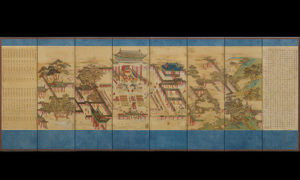
Joseon-dynasty queens could not become official rulers but could acquire political power indirectly through their male relatives, especially their sons and grandsons, who could become heirs to the throne. Ceremonies and celebrations demonstrated the legitimacy of their male heirs’ claims to the throne, and in this way reinforced the women’s power. For example, at the height of Queen Sunwon’s power, she was honored with two elaborate banquets depicted in the screen titled Fifty-ninth Birthday Banquets for Elder Queen Mother Sunwon. Royal protocol books were also created to meticulously document the ceremonies.
Museum visitors may notice in the paintings that queens were adorned with numerous hairpins and accessories, as women took great care to prepare for official ceremonies and other formal occasions. In Osher Gallery, phoenix-shaped hairpins and a ceremonial hairpin with a character symbolizing longevity demonstrate the creativity and elegance of women’s accessories at the time. These objects have been officially designated Important Folklore Cultural Heritage of Korea.
The Joseon dynasty’s royal culture became an influential model for the elite (yangban) class of the country, the highest social status outside of the royal court. Several paintings in Osher Gallery portray celebrations of accomplishments in a yangban man’s life, such as passing state examinations; processions to a new government post; and welcoming ceremonies for the governor.
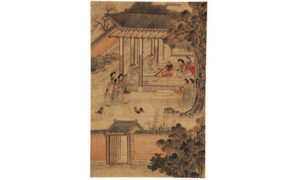
Also on display in this gallery are artworks commemorating birthdays, weddings and anniversaries, as well as objects used in ceremonies by members of the yangban class. Many of these objects are types still used in Korea today, reflecting the rich legacy of Joseon-dynasty traditions that continue to influence modern Korea. The past’s influence on the present is a theme highlighted by the inclusion of a contemporary artwork in the exhibition: Ommah, by the acclaimed artist Nam June Paik. Ommah (meaning mom) includes a traditional Korean robe hanging in front of an LCD monitor, symbolizing the way contemporary culture is often revealed under the cloak of tradition.
To enhance the visitor experience, the Digital Interactive Display provided by Leeum, Samsung Museum of Art, enables visitors to interact with the artwork. From intricate detail magnification to Samsung’s high-definition display, visitors can now enjoy art brought to life in a new digital fashion.
Technology equipment courtesy of Samsung.
The Asian Art Museum is the only venue for the exhibition.
This exhibition was organized by the Asian Art Museum in collaboration with the National Museum of Korea and the National Palace Museum of Korea based on the exhibition Scenes of Banquets and Ceremonies of the Joseon Period held by the National Museum of Korea in 2009.
Presentation at the Asian Art Museum is made possible with the generous support of Koret Foundation, Samsung, The Korea Foundation, The Bernard Osher Foundation, E. Rhodes and Leona B. Carpenter Foundation, Silicon Valley Bank, Jamie and Steve Chen, John and Barbara Osterweis, and Suno Kay Osterweis.
The Asian Art Museum–Chong-Moon Lee Center for Asian Art and Culture is one of San Francisco’s premier arts institutions and home to a world-renowned collection of more than 18,000 Asian art treasures spanning 6,000 years of history. Through rich art experiences, centered on historic and contemporary artworks, the Asian Art Museum unlocks the past for visitors, bringing it to life while serving as a catalyst for new art, new creativity and new thinking.
Information: 415.581.3500 or www.asianart.org
Location: 200 Larkin Street, San Francisco, CA 94102
Hours: The museum is open Tuesdays through Sundays from 10 a.m. to 5 p.m. From February through September, hours are extended on Thursdays until 9 p.m. Closed Mondays, as well as New Year’s Day, Thanksgiving Day and Christmas Day.
General Admission: Free for museum members, $12 for adults, $8 for seniors (65+), college students with ID, and youths (13–17). Free for children under 12 and SFUSD students with ID. Admission on Thursdays after 5 p.m. is $5 for all visitors (except those under 12, SFUSD students, and museum members, who are always admitted free). Admission is free to all on Target First Free Sundays (the first Sunday of every month). A surcharge may apply for admission into special exhibitions.
Access: The Asian Art Museum is wheelchair accessible. For more information regarding access: 415.581.3598; TDD: 415.861.2035.